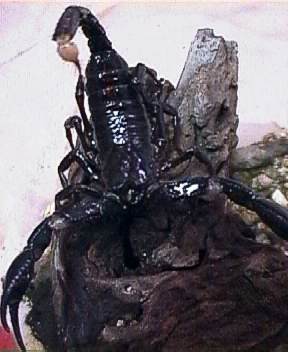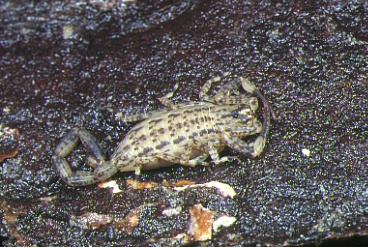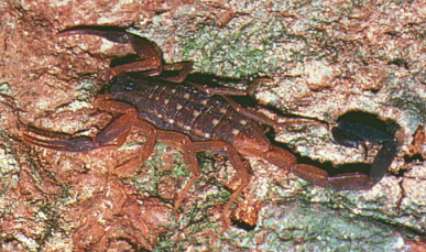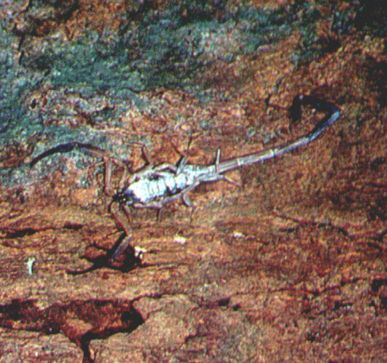
Heterometrus longimanus, copyright of Venom and Toxin Research group, NUS
Scorpions in Singapore
Being a small highly industrialised nation, conservation of nature plays second fiddle to economics and bread and butter issues. The few pockets of nature still exist in areas like Sungei Buloh, Central catchment areas, Bukit Timah Nature Reserve, Labrador park, small undisturbed stretches of beach along West Coast, Kranji area and outshore islands (including P.Ubin).
Despite the continuous damage hikers (like myself), indiscrimate collectors and developers does to our natural habitat, these areas still present a surprising diversity of flora and fauna. However, I personally notice a significant reduction of invertebrates and vertebrates(at least in appearance) compared to 10 years ago in Bukit Timah Nature Reserve and MacRitchie reservoir. The same may be said of others but since I do not visit them as often, I've no basis for comparision.
Scorpions in Singapore has not been well studied. From hearsay and personal experience, other than Bukit Timah Nature Reserve, Central Catchment Area and Mount Faber, scorpion encounter is generally rare.
So what scorpions can be found? Base on studies by others, the species which exist in Singapore are
1) Wood scorpion Liocheles (Hormurus)
australasiae
2) Asian forest scorpion or black scorpion (Heterometrus
longimanus)
3) Asian forest scorpion (Heterometrus spinifer)
3) Striped scorpion (Isometrus maculatus)
4) Bark scorpion (Lychas sp)
As studies on scorpions in Singapore is at best limited, I believe many more species awaits discovery.
Personal Encounters/Resources
I've personally seen scorpions of genus Heterometrus (Black scorpion) in Catchment area and Bukit Timah Nature Reserve. It takes no imagination to know it's colour. It is about 12 cm in length. Also seen in Bukit Timah Nature Reserve are some Buthids about 5cm in length. They most likely are Isometrus sp (Isometrus maculatus?)or Lychas sp or both.
The two references to Homurus australasiae comes from the 'Guide of Bukit Timah Nature Reserve' and 'Dangerous animals of Malaya' by M.W.F. Tweedie(1941). They are said to be about 2-4 cm. Homurus is a synonym of Lioscheles and the latter is used more commonly recently. I've seen specimens of these Ischnurids and is quite positive they are Lioscheles. Lychas scutatus is also briefly reported to exist in Malaysia. This a synonym of Lychas scutilus for those who may be confused. Lychas tweediei is first described by F. Kopstein in a 1937 journal as a new species in Malaya. Apparently, Frantisek Kovarik in his 1997 paper on revision of Lychas and Hemilychas puts it as a variation of Lychas hosei.
The exact profile of scorpions in Singapore is a big muddle and I am presently attempting to sort it out through examination of alcohol preserved specimens and collection trip (if the National Park authority allows).
Scorpions in Captivity in Singapore
Scorpions need not be found in the wild in Singapore. For those who's interested in
first hand encounter of scorpions, you just need to go to Butterfly park in Sentosa. If
you are lucky, there are experience handlers there to show and supervise handling of
scorpions. The scorpions in the park are kept in a well and a big tank and are of the
genus Heterometrus. When I last attempt to identify them, they are Asia giant forest
scorpion or Black scorpion, Heterometrus spinifer. Heterometrus
spinifer is not dangerously venomous but for your safety and in accordance with the
Park's regulation, DO NOT handle them without supervision and permission. It is a rare
opportunity for urbanites to see and even touch scorpions. you'll be surprise how smooth,
clean and docile they are. Some of the scorpions come from Cameron highland,
Malaysia.
The Butterfly Park is situated beside the Cable Car station in Sentosa (take a monorail or
Bus A from Ferry terminal). Entrance fee into Sentosa for adult is S$6.00 while the
Butterfly Park entrance cost another S$5.00. That adds up to quite a bit so why miss the
opportunity to know more about the fascinating scorpions if you do enter Sentosa.
Oh, by the way, I'm not an employee of the Park. Besides scorpions, there are many other
'creepy crawlies' and beautiful butterflies. This plus the huge collection in the museum
is really worth the money even if you're remotely interested. Then again, I take no
responsibility if you are disappointed.
Description of each species
A number of data is incomplete. Anyone with correction or new
info, pls email me. I will suitably acknowledge your contributions.
Heterometrus longimanus

Heterometrus longimanus, copyright of Venom and Toxin Research group, NUS
Order: Scorpiones
Family: Scorpionidae
Genus: Heterometrus
Common name: Black Scorpion, Asian Forest Scorpion, Malayan Giant Scorpion
Malay name: Kala Bangkang
Description: Big, black or dark green scorpion. Got a cleft between the
bases of the chelicerae (ID for Pandinus and Heterometrus). Big powerful
pedipalps with tubercle at the base of tarsus.
Max. carapace length: about 14 cm or 6 inches (average: 10-12 cm)
Habitat: Found under dead logs and crevices. Not commonly seen.
Behaviour: Wild specimens can be quite aggressive but handling for some time
tames them quickly. The large pedipalp is capable of drawing blood and some wild ones do
not hesitate to use them. They appear very reluctant to use their tail in most cases.
What to do when you meet one: Contrary to the common perception, scorpions
do not actively search for human to attack. Just leave it alone and it will retreat to a
safe place. Do not, I emphasise, DO NOT attempt to kill it. They are helpful in
controlling pest and are majestic creatures to behold. Moreover, an attempt to kill it may
result in being hurt when it act in defense. This holds true for all the scorpions stated
below. If you find one in your shoe or house, you may kill it, keep it as pet or transfer
it to any natural environment. I strongly recommend the third option.
Alternatively, if it's found in Singapore and you wish to give someone for ID, just keep
it alive in a small container and email me. I'll greatly appreciate that.
Venom: It is not known to be dangerous. As yet, I've not found the LD50
(measure of potency) for it's venom. Experience of stings by the scorpion results in local
swelling and pain which can last for hours to days. Its severity should be about that of a
bee or wasp sting. Since toxicity is related to numerous factors (refer to discussion on
venom), no conclusive statement could be made. In one of the many books on toxin, it is
reported that 14 people are killed in India by one of the Heterometrus sp. (H.swammerdami?).
No fatality or serious envenomation to my knowledge has been reported in Malaysia and
Singapore by this or related species.
Special notes: The genus Heterometrus was formerly under the name Palamneus
but Palamneus has since been disused. Some older literature and mounted
specimens may still use Palamneus which is actually Heterometrus. eg. Palamneus
fulvipes is actually Heterometrus fulvipes.(Revision of Heterometrus, Couzijn,
1981)
Preliminary identification by me on the live specimens and mounted specimens suggest
that most Heterometrus in Cameron is Heterometrus spinifer spinifer while most in
Singapore are Heterometrus longimanus. This is base on preserved specimens from the
Zoological Reference Collection. Also common in our region (especially Thailand,
Vietnam and Laos) is the species Heterometrus laoticus.
 Heterometrus spinifer in threat posture |
 Heterometrus spinifer |

A trio of Heterometrus laoticus in a shallow burrow
previously under dead log typical of many Heterometrus sp.
When substrate is favourable, Heterometrus laoticus may dig
deep burrow (>10cm deep)
Family: Buthidae
Genus: Isometrus
Common name: Common house striped scorpion
Malay name: NA
Description: Generally light yellow with brown or red vertical strips along
the opisthosoma. Got slender pincers characteristic of Buthidae. Got relatively long
metasoma.
Average carapace length: reported less than 5 cm.
Habitat: In cracks and crevices of kampongs. In Singapore, it's quite common
in Bukit Timah Nature Reserve and resides beneath the bark of trees and logs.
Behaviour: The ones I've found in Bukit Timah are not aggressive. They will
pince when handled but it is inconsequential. So far, the ones observed are not quick to
use their stings but definitely more prone to stinging than H.longimanus
Venom: The LD50 of the venom is not available. From studies done, it is
not potent but already represents the most venomous of the species in Singapore. Symptoms
may include local swelling, pain. Nausea and fever may sometimes be experienced. Since
this species belongs to the family Buthidae which includes most of the very dangerous
scorpions, it should be treated with respect. Stings should be avoided and any systemic
symptoms like respiratory difficulty should be refered to qualified physicians
immediately. No fatality has been recorded.
I'll be trying to identify the specimens using Fauna of India: Arachnid Vol 3: Scorpions' by Tikader and Bastwade (1983) and Revision of Lychas and Hemilychas genus by Dr Frantisek Kovarik. Specimens of this species has been seen in Singapore Zoological Gardens and I realised that the specimens in Bukit Timah are most likely Lychas species instead.
 Isometrus sp.? picture by Akio Tanaka |
 Isometrus maculatus (?), copyright of Venom and Toxin Research group, NUS |
Liocheles (Homurus) australasiae
Family: Ischnuridae
Genus: Homurus (Liocheles)
Common name: Wood scorpion, Bark scorpion
Malay name: Kala
Description: The pincer and body looks slightly flattened. It is black and
lacks the tubercle on the pincer which distinguish it from the young H.longimanus.
The metasoma of the female is much reduced while the male metasoma is comparatively long.
Looks like Hadogenes sp. but much smaller
Average carapace length: 3-4 cm (for male inclusive of the metasoma, up to 7
cm)
Habitat: Under dead logs and crevices. Can be found in Mount Faber. Used to
be very common in Malaysia.
Behaviour: I do not know as the only ones I've 'encountered' are sourvenirs,
pictures, preserved specimen and hearsay.
Venom: LD50 unknown. Thought to be the mildest of the three species but
should be expected to cause pain and minor swelling. The metasoma and telson look rather
small and weak and thus may not be able to penetrate skin of the adult palm. LD50 of
related Hadogenes sp is 1800mg/kg of mice (SC) which is very low potency indeed.
(Habermehl,1981)
Special notes: I was told that Homurus australasiae is actually a
older name of Liocheles australasiae. Lioscheles australasie should therefore be a
more suitable modern reference to the species. I used to thought that the scorpions in the
keychains may be a smaller species of Hadogenes and I turn out to be half right.
They are not but belong to the same family Ischnuridae. It is interesting to note
that this species is thought to reproduce by thelytokous parthenogenesis (ie. female
produce female offspring without fertilisation) which is rare among arachnids. According
to Koch 1977, the ratio of male : female is 1:29 while in the studies of Makiota and
Koike,1985, no males are found. It is also exceptional in that the male is on average
12.8% longer than the female (rare among arachnids).
I am presently using 'Fauna of India: Arachnid Vol 3: Scorpions' by Tikader and Bastwade (1983) to identify the specimens.

Picture by Akio Tanaka
Family: Buthidae
Genus: Lychas
Common name: Bark scorpion
Malay name: unknown
Description: Standard buthids look. Slender pincer, relatively long
metasoma.
Average carapace length: ?
Habitat: Cracks and crevices
Behaviour: ?
Venom: Genus Lychas is not known to be dangerous. However, being part
of the Buthidae and having so little information on this species, this species should not
be handled as far as possible. 3 death suspected due to Lychas sp occurs in
Australia in the last 100 years. One confirmed death from possibly Lychas sting
happens to a infant at Pemberton, W. Australia in 1929. This account is taken from 'The
Red-Back Spider and other Venomous Creatures (1980)" by L.E. Koch.
Special note: It is very briefly said to exist in the 'Dangerous animals of
Malaya' by M.W.F. Tweedie, 1941. I'm presently trying to identify scorpions found in
Singapore which will include Lychas sp. I am grateful and honoured to have the help
of Dr Frantisek Kovarik from Czech Republic who send me his recent publication on Lychas
taxonomy.

An unnamed local scorpion, copyright of Singapore Science Centre